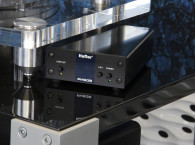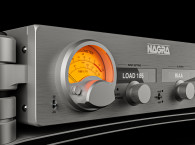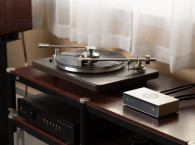Radial Engineering, Ltd., is a professional audio company based in Vancouver, BC, Canada. Its products are sold under several brand names, including Radial, Tonebone, Primacoustic, Reamp, and Zebracase. Radial was conceived by Peter Janis and Domenico Pingitore in 1992, and they began as Canadian importers for several well-known audio brands, including Mogami cable, Jensen Transformers, and Sonex acoustical products. After Pingitore left Radial, Janis decided to get into the manufacturing business, introducing Radial’s first direct box in 1996. Radial’s history can be found on its website.
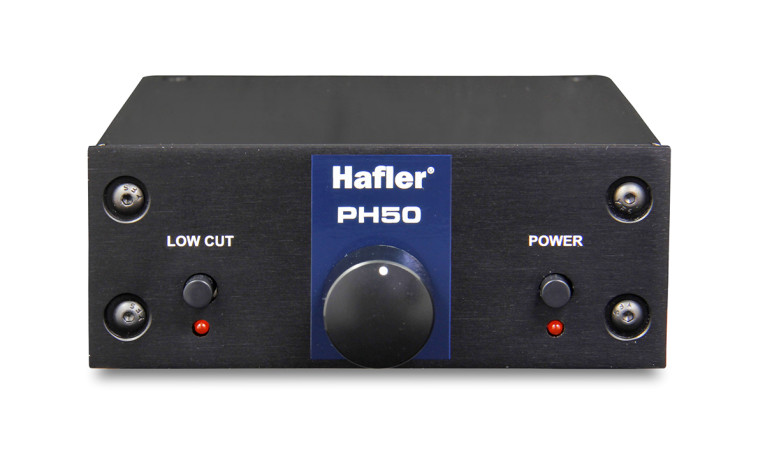
Jensen Transformers was founded by Deane Jensen in 1974. Jensen recognized that the mediocre sound quality of many mixing consoles and other audio products was due to badly designed transformers that did not work well with active circuitry. His innovations in transformer design included double-Faraday shielding for superior noise rejection and improved quality-control testing of core materials.
Jensen soon established his company as one of the leading manufacturers of high-performance audio transformers. After his untimely death in 1989, the company was taken over by his associate and friend Bill Whitlock. Technical excellence and innovation continued under Whitlock’s masterful guidance, maintaining Jensen’s preeminence in the transformer field to this day.
Radial has been closely associated with Jensen since the early 1990s. The company designed many products around Jensen transformers, and eventually became Jensen’s biggest customer. Upon Whitlock’s retirement in 2014 at age 70, Jensen Transformers became a division of Radial Engineering. Fortunately, Jensen has continued to benefit from Whitlock’s expertise, retaining him as a technical consultant.
Hafler History
David Hafler founded The Dyna Company in 1955 with business partner Ed Laurent, offering a 50 W mono power amplifier — the Mark II — as their first product. As with all subsequent Dynaco products the Mark II was available as a kit or factory-assembled. This amplifier was followed in 1956 by the Mark III and in 1959, with the arrival of the stereo LP — the legendary Stereo 70. Dynaco sold more than 300,000 Stereo 70 power amplifiers over the life of that product. Other highly regarded tube products included the PAS-2 and the PAS-3X stereo preamps, and the FM-3 tuner. Dynaco launched its first solid-state products in 1966 — the PAT-4 stereo preamp and Stereo 120 power amplifier. Pared-down versions of those two products formed the basis for the SCA-80 integrated amplifier. Other Dynaco solid-state offerings included the Stereo 150, the 400, and the 416 power amps, the PAT-5 and the PAT5 BiFET preamps, and the FM-5 tuner.
Dynaco introduced the Dynaquad four-channel adapter in the early 1970s, which simulated ambiance information in a pair of rear loudspeakers, by simply inserting a 10 Ω resistor between the front and rear-channel grounds. No additional amplification was needed, and Dynaco incorporated this pseudo-quad system into the SCA-80. Dynaco’s loudspeakers — the A25, the A35, and the A50 — were designed and built in Denmark using SEAS drivers. The loudspeakers were remarkable for their natural, low-coloration sound. Many critical listeners found the A-25 to be equal or superior to Acoustic Research’s considerably more expensive AR-3a, which at the time was considered a benchmark among home high-fidelity loudspeakers.
Hafler sold Dynaco to Tyco, Inc., in 1966, but he continued to work with the company until 1974. After a few years with Ortofon, he founded The David Hafler Company in 1977, returning to the kit business with the DH-101 stereo preamplifier. This was followed by the DH-200 and the DH-500 MOSFET power amplifiers, and the DH-110 preamp. As with their Dynaco ancestors, these reliable and cost effective products were enormously popular with kit builders, and inspired several modification articles in audioXpress’ predecessor, The Audio Amateur.
David Hafler retired and sold his company in 1987 to Rockford Corp. Under Rockford’s management, the Hafler brand moved toward the pro-audio market rather than consumer products. Radial began its connection with Hafler as the Canadian distributor for Hafler amplifiers, ultimately purchasing the company in 2014. Radial now plans to reintroduce some of the classic Hafler and Dynaco amplifiers. Now on the market shortly is a completely updated tube amplifier based on the Dynaco Stereo 70. Information on all new Hafler and Dynaco products can be found on the Hafler website (www.hafler.com).

Hafler Phono Preamps
Since its acquisition by Radial, Hafler has introduced four power amplifiers (ranging from two to 12 channels), two headphone amplifiers (one tube, one solid state), two RIAA phono preamps, and two moving coil step-up transformers. The step-up devices incorporate Jensen transformers designed specifically for this purpose.
The PH50 phono preamp has 35 dB of gain and is designed for moving magnet cartridges with outputs in the 3-5 mV range (see Photos 1–3). It will also work fine with moving iron cartridges with similar output levels (e.g., the Grados). The PH60 has 70 dB of gain and was designed for low-output, moving coil cartridges (see Photo 4 and Photo 5). Cartridges of this type generally have output levels well under 1 mV, with most falling in the 0.3 to 0.5 mV range.
Both preamps are based on the Texas Instruments (TI) LM833-N dual IC op-amp. The LM833-N features a 4.5 nV/√Hz low input noise voltage, a slew rate of 7 V/μS, and total harmonic distortion (THD) of 0.002%. This device has been designed with a special emphasis on audio applications and has the same noise, distortion, and slew rate specs as the older LM833. The main differences appear to be in the manufacturing process and the “typical” gain-bandwidth product, which is 16 MHz for the LM833 and 15 MHz for the LM833N (minimum for both is specified at 10 MHz).
According to TI’s datasheet for the LM833-N, “This dual amplifier IC utilizes new circuit and processing techniques to deliver low noise, high speed, and wide bandwidth without increasing external components or decreasing stability.” Page 14 of the TI LM833-N datasheet contains an RIAA phono preamp circuit. A look inside the PH50 reveals that Hafler has used the TI circuit in this preamp. The only differences are the values of the input and output coupling capacitors, which TI set at 33 μf and 10 μF, respectively. Hafler changed each to 22 μF. The circuit, as modified by Hafler, is shown in Figure 1.
The RIAA feedback circuit is the familiar “Network A” (Lipshitz nomenclature). Since the LM833-N is unity-gain stable, no amplifier stability resistor is needed in the feedback circuit. This also puts the high-frequency rise in response well above 20 kHz, so no output R/C low-pass filter is needed for correction. The 390 Ω resistor and the 100 μF capacitor set the low-frequency -3 dB point at about 4 Hz. The capacitor also ensures unity gain at DC, which will maximize headroom.
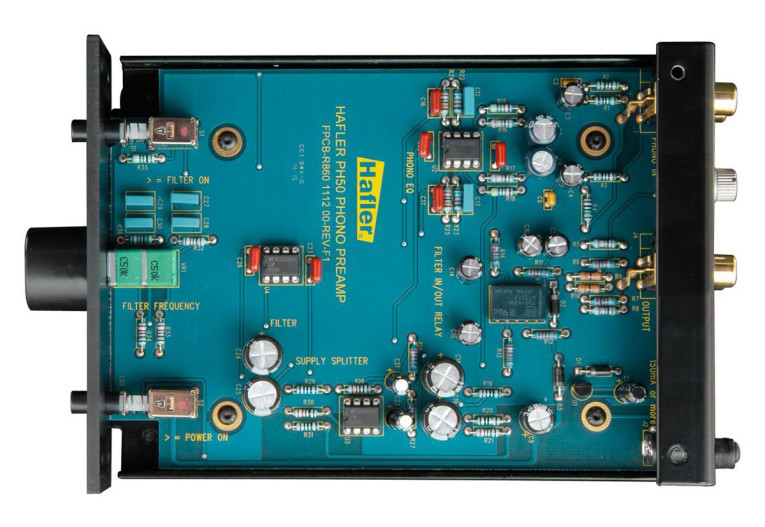

input and output coupling capacitors to 22 μF.
RIAA Accuracy
I’m always interested in running simulations on RIAA circuits, but feedback-based circuits with composite networks require a SPICE macromodel for the specific op-amp used. Unfortunately, TI doesn’t have a macromodel for the LM833-N, but one for the LM833 is available for download. Since the gain-bandwidth product is nearly identical in these two devices, I decided to use the LM833 macromodel (I simulated this circuit with several audio-grade op-amps and found that the response in the upper two octaves varied by no more than 0.06 dB).

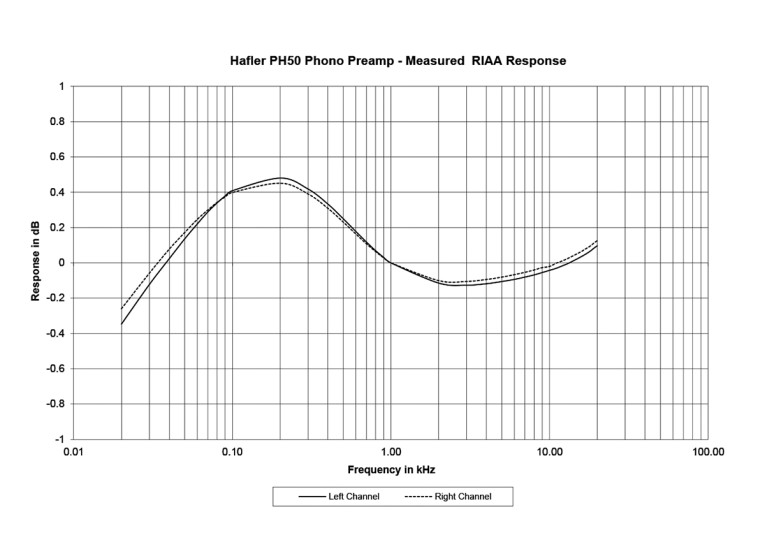
Figure 2 shows the simulation results, which demonstrates that the circuit is capable of RIAA accuracy ±0.3 dB from 20 Hz to 20 kHz. Actual performance will depend on component tolerances. I measured the RIAA accuracy of my review sample using an Owon AG-1012F signal generator, my actively-buffered Jung-Lipshitz precision inverse RIAA network, and a Hewlett-Packard/Agilent 34401A digital multimeter, giving all equipment a two-hour warm up period. The Agilent meter has a decibel function with adjustable resolution of three to five decimal places. I outlined a procedure for measuring RIAA response in a sidebar to my article “Adcom’s GFP-565 Preamplifier (Part 4)“ (audioXpress, February 2004). Although my signal generator and meter are different, the procedure is essentially unchanged.
Figure 3 shows the measurement results. The measurement curve is very close to the simulation, with the left channel ±0.4 dB and the right channel ±0.36 dB, 20 Hz to 20 kHz. Both channels are around 0.3 dB down at 20 Hz, due to the 100 μF capacitor in the feedback network. From 30 Hz to 20 kHz, the left channel accuracy is ±0.3 dB and the right is ±0.28 dB.
Although perfectionist audio enthusiasts such as myself would like to see RIAA accuracy with ±0.1 dB, achieving that requires spending a great deal more money and invariably involves series or parallel combinations of off-the-shelf resistor values and parallel capacitors — often hand-selecting the parts for close tolerances. Even the renowned John Curl-designed Parasound JC-3+, priced at $2,995, claims ±0.2 dB, and a survey of under $500 phono preamps shows most are in the ±0.3 to ±0.5 dB range. The Hafler PH50 is certainly competitive with other phono preamps in this price range.
One feature of the PH50 is the variable rumble filter. This is a switchable, 12 dB/octave filter, based on another LM833-N op-amp, with a low-frequency cutoff that can be varied with a potentiometer on the front panel. The front-panel filter I/O switch activates a small relay mounted close to the output jacks.
Strangely, Hafler doesn’t specify the low-frequency cutoff range. Measurements on my sample show it to be -3 dB at 23 Hz in the counterclockwise position, 107 Hz in the center, rising to 490 Hz fully clockwise (the nominal values are probably 20 Hz, 100 Hz, and 500 Hz). This flexibility is much more sensible than the now-discarded (and discredited) International Electrotechnical Commission (IEC) amendment to the RIAA playback curve, which added a 7950 μS time constant. The IEC amendment put a fixed -3 dB rolloff at 20 Hz, which was invariably audible on systems with extended low-frequency response. The Hafler approach enables user discretion in dealing with rumble and record warp problems.
The PH50 is supplied with a wall wart external power supply rated at 15 VDC out at 400 mA. Wisely, Hafler has avoided the cheap, switching-mode wall warts that are becoming increasingly common with consumer audio equipment. Hafler uses a real 60 Hz power transformer, and keeping it external prevents hum from compromising the noise performance of the preamp. (The PH50’s 14 AWG steel case also helps. This same case is used for all Hafler phono products.) Under the load presented by the PH50, the transformer puts out 20 VDC. Inside the PH50 chassis, this is regulated down to +15 VDC with 78L15 three-terminal IC regulator. A third LM833-N is used as a supply splitter, delivering ±7 VDC to the phono preamp and rumble filter op-amps.
The PC board in the PH50 is a conventional through-hole type, with plated through-holes. Hafler describes the PC board as being “military spec for greater durability” and it also notes that a “full surface ground plane reduces susceptibility to radio frequency interference.”
There are no surface-mount components. All passive parts are leaded, and all resistors are metal-film types. The three op-amps are 8-pin DIP packages. The older products made by Dynaco and Hafler have long been favorites of modifiers. I’m sure the use of through-hole parts in their new phono preamps will make them attractive to DIY readers. Just remember that any modifications will likely void your warranty!
Vinyl Listening
I auditioned the PH50 using a Systemdek IIX turntable fitted with an Audio Technica AT-110E moving magnet cartridge. The AT110E is no longer part of Audio Technica’s North American product line, but it can be purchased from LP Gear for less than $70. It’s a remarkable cartridge for the money, offering performance that belies its modest price. With an output of 4.5 mV, the AT110E proved an ideal match for the 35 dB of gain provided by the PH50. The PH50 is exceptionally quiet — literally a silent partner during my listening sessions. At full preamp gain, with my ear up to the speaker (no music, of course!), there’s just a trace of hiss. It offered clean, detailed sound with reasonably good soundstage information and dynamics. Compared to higher-end phono preamps, the soundstage is a bit narrow and the depth a bit short, but in this price range I have no complaints.
I also tried the PH50 with the Grado Signature XTZII that I normally use in my Grado Signature Tonearm, mounted on my custom AR-based turntable (see Resources for articles about the AR-based turntable). This turntable is fitted with George Merrill’s GEM Dandy Rubber Cork Compound Platter Mat (which may be the best $60 you’ll spend on your turntable). The moving-iron XTZII has low output for this type of cartridge — about 1.7 mV.
Although I had to increase my preamp gain to compensate, the PH50’s low noise floor was never audible during my listening. Most importantly, the resolution of the PH50 is good enough to reveal the main differences between these cartridges, with the high-end Grado cartridge offering greatly increased detail, lower distortion, and better spatial characteristics.
Incidentally, both turntables were powered by my low-distortion electronic speed control (see Resources for the original article describing this project), which I completely overhauled several years ago. There are a lot of choices in the under $500 phono preamp world, but the Hafler PH50 is a competitive product, and the unique rumble filter will make it attractive for many users.

Moving Coil Preamp
The PH60 moving coil preamp uses the same LM833-N-based RIAA circuit as the PH50 and the same type of construction, including the PC board and leaded components. The design is transformerless. The high-gain front-end to step up the low output from moving coil cartridges is discrete, employing eight 2N4403 transistors in parallel. This is a well-known approach to moving coil step-up, combining high-gain with very low noise. The 2N4403 is a general-purpose, bi-polar PNP transistor with a current-gain-bandwidth product (fT) of 200 MHz. Since the paralleled transistors are operated single-ended, this gain stage is, by definition, pure Class A.
The PH60 offers three choices for cartridge loading — 50 Ω, 100 Ω, and 200 Ω — set with jumpers on the PC board. The factory setting is 100 Ω, which is the most common load requirement for moving coil cartridges. There are spaces on the PC board for adding a fourth load resistor if the three supplied resistors don’t match your cartridge. Since the PC board accommodates leaded components, this will be an easy addition in the field.

The PH60 comes with the same wall-wart transformer as the PH50, supplying -18 VDC under the load presented by the preamp. (Polarity from the outboard supply is simply a matter of the preamp’s DC supply connector orientation.) Since the discrete front-end is operated from a single-ended power supply, Hafler opted to power the LM833-N op-amp the same way. A 7912 three-terminal negative regulator steps the -18 VDC input down to -12 V to power the front-end and the op-amp. Electrolytic coupling capacitors are used at the preamp’s input, output, as well as between the front-end and the LM833-N RIAA stage. The PH60 has a fixed, switchable passive rumble filter inserted between the front-end and the RIAA stage. Again, Hafler doesn’t specify the rumble filter characteristic — I measured a 6 dB/octave roll-off with a -3 dB point of 90 Hz, which is higher than I would have expected.
I auditioned the PH60 using a Denon DL-103R moving coil cartridge mounted in my Grado arm. The performance of the PH60 was impressive, especially considering its reasonable price. The output of the Denon cartridge is 0.3 mV —rather low even for a low-output moving coil (Denon specifies 0.25 mV, but the calibration sheet that came with mine indicated 0.3 mV).
Many moving coil RIAA preamps are designed with a 1 kHz gain of 60 dB, but the Hafler’s 70 dB of gain was definitely beneficial for this cartridge. The PH60 delivered plenty of output to my preamp, without any audible noise at any normal listening level. At full preamp gain the broadband hiss is a bit higher than the PH50, but still extremely low. There’s no trace of hum.
The preamp also revealed all of the essential qualities that moving coil advocates admire in these cartridges, including an airy, open treble region, excellent inner detail, and a large, precisely-localized soundstage. The DL-103R is slightly elevated in the treble compared to my more neutral Grado XTZII, and the PH60 simply did what it was told in this regard. At no time was the treble harsh or fatiguing. This preamp is good for long-term listening. Building a clean, quiet preamp to match the gain requirements of very-low output cartridges is a challenge for any designer, especially in this price range. Hafler has certainly succeeded with the PH60.

Moving Coil Transformer
Some moving coil cartridge enthusiasts prefer a step-up transformer to an active front-end. In this case, the step-up transformer feeds a regular moving magnet phono preamp. A transformer is a passive device, and won’t introduce any additional broad-band hiss, but at such low signal levels there’s always a potential for hum.
Dave Hill, General Manager of Jensen transformers, provided some history behind the Hafler moving coil step-up products. Deane Jensen’s research on moving coil step-up transformers began in the late 1970s, resulting in Jensen products that are still in production today. Jensen worked with an audio accessories company called Audio Interface, owned by Fujio Suganuma, based in Van Nuys, CA.
“Numa-San” helped Deane with listening tests of the prototypes, which led to the creation of the Jensen JT-34K-DX and the JT-44K-DX moving coil transformers. Audio Interface became the first company to produce a high-performance, passive moving coil step-up device, the l CST-80, which could be purchased with either of the Jensen transformers.
Hill notes that Deane Jensen was particularly proud of those transformers. The Audio Interface CST-80 is still highly regarded — they fetch real money on the used market when they turn up. With Jensen now a division of Radial, it’s only logical that Hafler would make a line of moving coil step-up devices using Jensen transformers. There are currently two Hafler step-up transformers, the PH34 and the PH44, named for the Jensen JT-34K-DX and JT-44-DX transformers they contain. The PH34 is designed for very-low-impedance cartridges and has 31 dB of gain and an input impedance of 31.5 Ω. The PH44 has 20 dB of gain and an input impedance of 430 Ω (see Photo 6 and Photo 7).
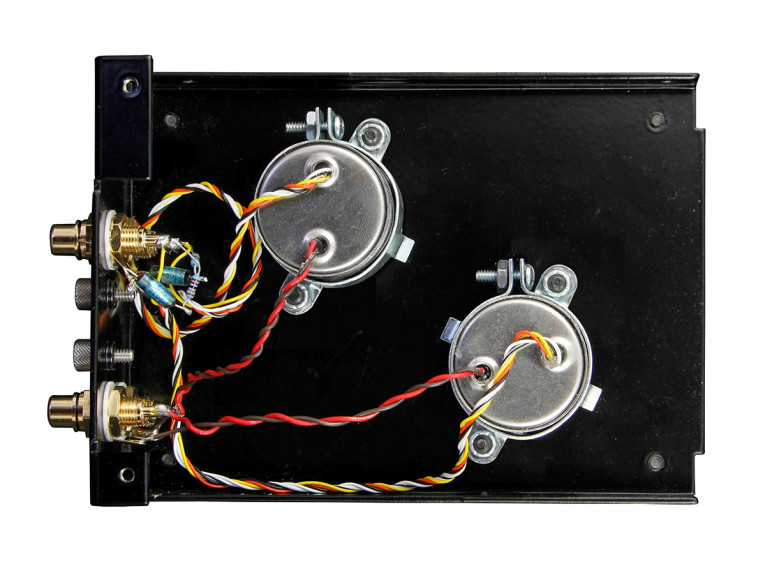
In the datasheets for these transformers, Jensen recommends an output Zobel network to ensure clean square-wave response with no overshoot or ringing – they’re included in the Hafler products. The series R/C network is placed in parallel with the transformer secondary, 13 kΩ + 100 pF in the PH34 and 6.8 kΩ + 200 pF in the PH44. DIY builders can also purchase the Jensen transformers separately, and mount them in their own cases or preamps, adding the recommended R/C networks.
The PH44 was supplied for this review, since it’s the best match for my Denon DL-103R. Although Denon recommends a 100 Ω load for this cartridge with an active front-end, they specify a 40 Ω load with a transformer. I asked Hill about this issue. Some transformer manufacturers suggest adjusting the primary input impedance by adding a resistor across the secondary, effectively in parallel with the 47 kΩ input impedance of a typical moving magnet phono preamp. The lower secondary loading will be reflected back to the primary, in accordance with the impedance ratio of the two windings.
Jensen strongly believes that this is the wrong approach, especially with an output R/C network already in parallel with the secondary. Lowering the 47 kΩ preamp load resistance will alter the square-wave response, degrading the sound, and also lower the transformer output level due to the additional loading. Jensen’s approach is to put an appropriate resistor in parallel with the transformer primary, which won’t affect the transformer’s gain or square-wave response.
Hill recently helped a DIY customer find the best loading for the DL-103R cartridge. The customer found that Denon’s 40 Ω recommendation made the cartridge sound “way too heavy” and that a 100 Ω load made it sound “dark and veiled.” The customer thought that the transformer’s 430 Ω load was just right.
For readers who want to experiment with off-the-shelf resistor values, a parallel resistance of 130 Ω will lower the Jensen JT-44K-DX transformer’s primary impedance to 100 Ω. A 47.5 Ω resistor will bring it down to 42 Ω. There’s plenty of room to work inside the Hafler case, so soldering a resistor across each input jack is an easy task. My findings were different.
To my ears, 430 Ω sounded too bright and thin, with a bit of hardness in the treble. I found 100 Ω to be better, but still too bright. I finally settled on 42 Ω, which provides a tonal balance very close to the PH60 active preamp with 100 Ω loading. One benefit of adding a parallel resistance across the input is that it gives the cartridge a more uniform load with frequency.
I used my BK Precision 879B LCR meter to measure the PH44’s primary impedance, with a 47 kΩ load across the secondary. The 879B can measure impedance at four frequencies, and under the load presented by the transformer, its sine-wave output is just under 300 mVRMS. I checked the transformer secondary on my oscilloscope to make sure the transformer wasn’t saturating at any of the test frequencies. I measured 375 Ω at 100 Hz, 433 Ω at 1 kHz, and 343 Ω at 10 kHz. The variation in impedance is because inductive reactance of the transformer primary coil varies with frequency (this will be true of any transformer).
After adding a 130 Ω resistor across the primary, the readings were 97 Ω, 100 Ω, and 98 Ω at those same frequencies. With 47.5 kΩ across the primary, the readings became 43.2 Ω, 42.8 Ω, and 42.7 Ω. With the purely-resistive portion of the load now dominant, the impedance “curve” is very uniform. This should be beneficial to the performance of the cartridge.
Opinions on the Internet about loading for the DL-103R are all over the map, from as low at Denon’s recommended 40 Ω to as high as 1 kΩ. A few users note that 47 kΩ is the load Denon claims they use to generate the individual frequency response curves that come with each cartridge. This is true, but it can’t be right. Denon makes its own AU-300LC moving coil step-up transformer for the DL-103 series of cartridges, with a primary impedance of 40 Ω. If Denon used its own transformer to make the measurement, it couldn’t possibly have loaded the cartridge with 47 kΩ. I believe that 47 kΩ probably refers to the loading of the transformer secondary, which is the load presented by virtually any moving magnet phono preamp it’s likely to be used with.
The diversity of opinion about cartridge loading may be related to the associated equipment. I use wide-band, solid-state equipment, including a Benchmark DAC2-HGC DAC/preamp, my own custom built preamp, and a pair of Benchmark AHB2 power amps. Tube equipment often has a softer treble region, and less well-defined bass, which may explain the preference for higher-impedance loading by some users. There’s clearly some “black art” involved here.
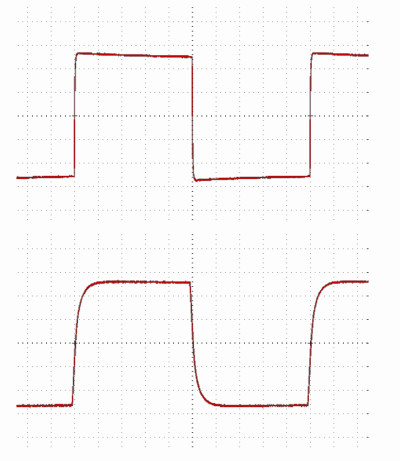
Transformer Performance
All of my past experiences with Jensen transformers have been extremely positive, and the PH44 is no exception. Figure 4 shows the transformer’s square-wave response at 1 kHz and at 10 kHz. The performance is excellent, and the absence of ringing or overshoot shows the effectiveness of the output R/C network. I auditioned the PH44 with my own custom-built moving magnet phono preamp (see Resources). The combination yielded extremely clean, detailed sound with a large, deep, well-defined soundstage. With my preamp gain set to maximum there’s not a trace of hum, and no more broadband hiss than that of the moving magnet preamp that it feeds.
But, getting the best performance from this transformer is dependent on proper cartridge loading. The Jensen transformers are sonically transparent and will reveal even small changes to their operating environment or that of the cartridge itself. If I were to make one suggestion to Hafler, it would be to add a small PC board at the input, enabling the user to easily change load resistors with jumpers, as they have in the PH60 preamp.
The PH44 is a winner. It’s refined enough to be used with the finest moving magnet phono preamps, and I recommend them to any moving coil user who prefers a step-up transformer to an active front-end. All of the Hafler products discussed in this article are made in Canada and feature robust construction. The long-term reliability should be excellent. ax
Editor’s Note: All audioXpress articles from 2001 to present can be found on the aX Cache, a USB drive available from www.cc-webshop.com.
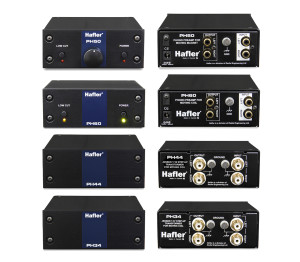 Hafler - A Division of Radial Engineering
Hafler - A Division of Radial Engineering1588 Kebet Way, Port Coquitlam
BC Canada V3C 5M5
(604) 942-1001
www.hafler.com
info@hafler.com
Hafler PH50 Phono Preamp: $449.99
Hafler PH60 Phono Preamp: $499.99
Hafler PH44 Moving Coil Step-Up Transformer: $999.99
Resources
Audio Advisor | www.audioadvisor.com
G. Galo, “AR System Drives New Turntable,” The Audio Amateur, March 1985.
———, “An Electronic Speed Control, ” The Audio Amateur, January 1986.
———, “The Belt Driven Turntable Revisited,” The Audio Amateur, March 1988.
———, “Adcom’s GFP-565 Preamplifier (Part 4),” audioXpress, February 2004.
———, “A Belt-Drive Turntable Upgrade,” audioXpress, July 2008.
Jerry Raskin’s Needle Doctor |www.needledoctor.com
KAB Electroacoustics | www.kabusa.com
Sources
Denon DL-103R Moving-Coil Phono Cartridge
Denon | www.denon.com
GEM Dandy Rubber Cork Compound Platter Mat
GEM Danday Products, Inc. | www.hifigem.com
Grado Moving-Iron Phono Cartridges
Grado Labs | www.gradolabs.com
Jensen Moving-Coil Transformers
Jensen Transformers | www.jensen-transformers.com
Audio Technical AT-110E Moving-Magnet Phono Cartridge
LP Gear | www.lpgear.com
Manufacturer’s Specifications
Hafler PH50 Phono Preamp
Audio circuit type: Active operational amplifier
Frequency response: RIAA curve
Total harmonic distortion (THD+N): 0.008%
Dynamic range: 91 dB
Input impedance: 47 kΩ
Maximum input: -21 dBu
Gain: 35 dB at 1 kHz
Clip level output: +12 dBu
Output impedance: 400 Ω
Equivalent input noise: -79 dBu
Noise floor: -79 dBu
Intermodulation distortion: 0.04%
Controls: Low-pass cutoff
Switches: Low-pass ON, power
Low-cut filter: 20 Hz to 500 Hz
Filter Slope: 12 dB/Octave
Size: 4.5” (w) × 6” (d) × 1.75”(h) (114 mm × 152 mm × 44.5 mm)
Power: 15 V, 400 mA external supply
Warranty: 3 year transferable
Hafler PH60 Moving-Coil Phono Preamp
Circuit: Active discrete transistor & operational amplifier
Inputs: RCA (left/right)
Output: RCA (left/right)
Impedance: May be set by user via internal jumpers—25 Ω, 50 Ω, and 100 Ω and
custom
Gain: 70 dB at 1 kHz
Size: 4.5” (w) × 6” (d) × 1.75” (h) (114 mm × 152 mm × 44.5 mm)
Power: 15 V, 400 mA external supply
Warranty: 3 year transferable
Hafler PH34 Moving-Coil Step-up Transformer
Circuit: Passive transformer based design
Inputs: Gold-plated-RCA
Output: Gold-plated-RCA
Impedance: Optimized for 3 Ω to 5 Ω cartridges
Gain: 31 dB
Size: 4.5” (w) × 6” (d) × 1.75” (h) (114 mm × 152 mm × 44.5 mm)
Power: Not required
Warranty: 3 year transferable
Hafler PH44 Moving-Coil Step-up Transformer
Circuit: Passive transformer based design
Inputs: Gold plated RCA
Output: Gold plated RCA
Impedance: Optimized for 45 Ω cartridges
Gain: 20 dB
Size: 4.5” (w) × 6” (d) x 1.75” (h) (114 mm × 152 mm × 44.5 mm)
Power: Not required
Warranty: 3 year transferable
About the Author
Gary Galo retired in 2014 after 38 years as Audio Engineer at The Crane School of Music, SUNY at Potsdam, NY. He is also a Crane alumnus, having received a BM in Music Education in 1973 and an MA in Music History and Literature in 1974. Gary is a widely-published author with more than 300 articles and reviews on both musical and technical subjects, in over a dozen publications and has been writing for audioXpress and its predecessors since the early 1980s. He has been an active member of the Association for Recorded Sound Collections (ARSC) since 1989, a frequent presenter at ARSC conferences, and has authored numerous articles and reviews in the ARSC Journal. Gary is the author of the “Loudspeaker” entry in The Encyclopedia of Recorded Sound in the US. He has also written several articles for Linear Audio. He is a member of the Audio Engineering Society, the Boston Audio Society, and the Société Wilhelm Furtwängler.
This article was originally published in audioXpress, April 2017



